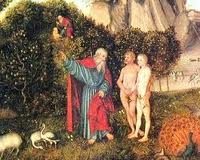 Marc Zvi Brettler, Dora Golding Professor of Biblical Literature at Brandeis University, and also one of my co-authors on The Bible and the Believer: How to Read the Bible Critically and Religiously
Marc Zvi Brettler, Dora Golding Professor of Biblical Literature at Brandeis University, and also one of my co-authors on The Bible and the Believer: How to Read the Bible Critically and Religiously, recently posted some thoughts at TheTorah.com on the two creation stories in Genesis and how each portrays God differently.
I think this will be of some help to many of you. He lays out succinctly (1) how to tell that there are in fact two creation stories, and (2) the different portraits of God in each.
He concludes by saying that the Bible as “a polyphonic text—a work that speaks in many voices… is the strength of the Bible rather than a weakness.” He continues,
Different people relate to one or another of these divine portraits—some of us are drawn to an approachable God, and being that is more be like us, while for others, a majestic, distant deity is more “Godlike.” Sometimes this can even shift with time and need—the very same person may sometimes need to connect to a God who walks about the Garden at the breezy time of the day (Gen 3:8), while at other times they may need to connect to a God who insists that all is ordered and in its place, good, indeed very good. Post-biblical Judaism used interpretation to discover different images for God in the Bible—no two parshanim or philosophers shared identical images of what God was like. But this inability to pin God down, to create one single, uniform, univocal image of God already has strong roots in the biblical text itself.
Bottom line for Brettler: You can’t pin God down. The Bible tells us so.
Note how a Jewish reading celebrates diversity in Scripture–even diverse portraits of God–whereas Protestant readers, particular evangelicals and fundamentalists, tend to seek a singular, unified voice in Scripture–and do some fretting when they don’t find one.
Jewish readings of Scripture see diversity as a property of a sacred, inspired text. Conservative Protestants see it as a characteristic that is incompatible with divine inspiration and thus needing to be “solved.”
Personally, I have long thought that a Jewish approach to diversity in Scripture is preferable, given the degree of  theological diversity that is self-evident in Scripture itself–the two creation stories being only a small sampling of that. That is why chapter three of Inspiration and Incarnation: Evangelicals and the Problem of the Old Testament
theological diversity that is self-evident in Scripture itself–the two creation stories being only a small sampling of that. That is why chapter three of Inspiration and Incarnation: Evangelicals and the Problem of the Old Testament deals with theological diversity.
******************
Brettler is also author of numerous other books, including How to Read the Jewish Bible, and co-editor of The Jewish Study Bible
and The Jewish Annotated New Testament
. He is also cofounder of Project TABS (Torah and Biblical Scholarship) -TheTorah.com.
